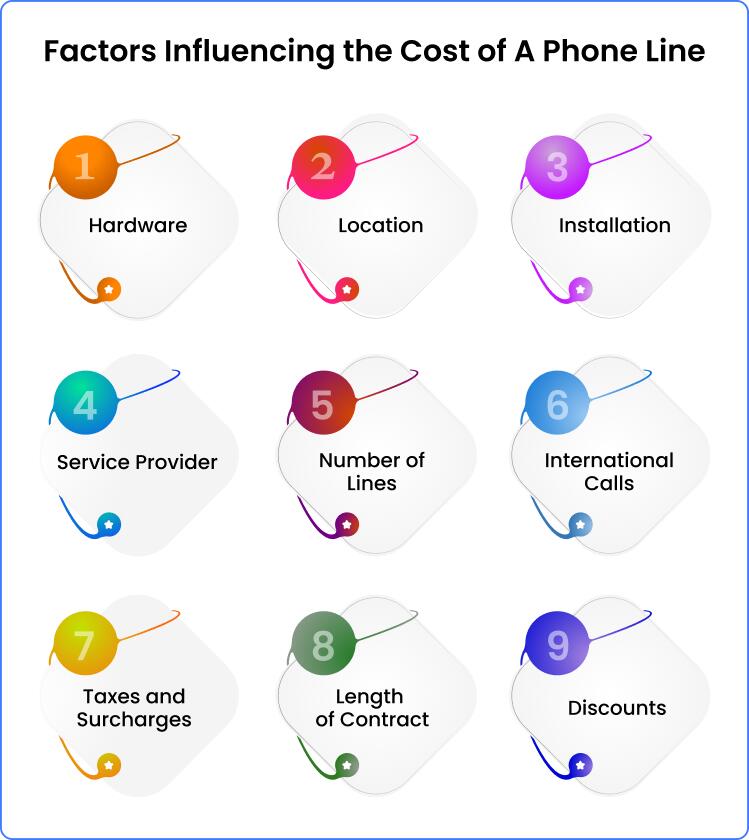
Whether you are a startup, a growing enterprise, or a well-established organization, having a robust and reliable business phone line is crucial for effective communication. However, the costs involved in setting up a high-end phone line become a concern, especially for small businesses. If you are also clueless about exactly how much a phone line costs, then don’t worry! The very purpose of this post is to provide you with a piece of detailed information on the factors that impact the cost of a business phone line.
Also, you will be equipped with the knowledge about how much should you be actually spending on your phone line. In addition, you will learn how to choose the best phone line for your business without breaking the bank.
How Much Does a Phone Line Cost?
It is quite tricky to give an exact price quote for how much a phone line costs. However, most of today’s businesses opt for VoIP phone lines and a straightforward figure for the cost of a VoIP phone line typically ranges between $15 and $30 per month per user. That being said, the actual cost of a business phone line (all types) depends on several factors that I will explain next.
Factors Impacting the Cost of a Business Phone Line
So what exactly drives the cost of your business phone line? Well, several key factors are behind the price of your business phone. Let’s understand these key elements so that you can make an informed decision when choosing the right business phone system.

Installation Fee
Setting up a new phone line often involves an upfront installation or activation fee, usually a one-time charge. In simpler setups, the fee is usually nominal from anywhere between $50 to $150. However, for more complex installations, this charge is usually high. In some cases, the provider might waive this cost, such as for a very long-term contract.
For example, if you are going with a traditional landline setup, then you need upfront investment in physical wiring and an on-site PBX system. You’ll need additional wiring as you add employees.
Your Phone Set Requirements
The first thing to keep in mind is that the type of phone system you choose will determine what kind of and how much hardware you will need.
Also, let’s not forget that physical phone sets such as desktop phones, cordless, hybrid, or wireless phones, and IP phones are usually a part of business setups no matter which phone system you choose.
Standard desktop phones start around $350, making them a cost-effective option for basic communication needs. However, feature-rich models command a higher price tag. For teams with high call volumes, wireless headsets (around $325 each) are a worthwhile investment. This can help boost productivity and comfort for your team by enabling hands-free calling and multitasking.
Your Location Matters
Just like we pay different to rent for different geographical locations, phone line costs also vary depending on your zip code i.e. country, state, or region. Urban areas typically prove to be more advantageous because of the availability of ample service providers and thus competitive pricing. On the other hand, rural locations might have limited options and slightly higher costs due to infrastructure requirements.
The Service Provider You Choose
Majorly, the cost depends upon the type of provider chosen – traditional phone companies, VoIP providers, etc. Every service provider has its own plans and pricing structures. You may find some providers offering bundled services combining phone, and internet services.
The Number of Lines and Users
This factor directly impacts the cost of your phone line. Plans that support more lines and users will automatically cost more. However, some providers may offer attractive discounts for bundling multiple lines or signing up multi-user plans. You may explore such options to save if your requirements are large.
Regular phone lines typically cost between $20 and $50 per month per line, translating to $240 to $600 annually.
Your International Calling Needs
If your business requires frequent international calling such as connecting with overseas clients, then this may add up to your phone’s bill. Make sure to inquire about your provider’s pricing structure for international calls such as per-minute charges or bundled international calling packages.
Additional Features
Modern businesses need modern phone features to stay competitive. Whether it is call recording, video conferencing, auto attendant, voicemail, or call forwarding, most businesses demand additional features. And yes, all these add-ons come at an extra price. Typically, the cost of each feature ranges between $3 to $10 per month and is usually a part of higher-tier plans.
Applicable Taxes and Regulatory Fees
Taxes and surcharges usually vary based on your location and the provider you choose. These surcharges can add 10% to 20% to your monthly phone line charges. You may consider reviewing and factoring these charges in your phone line cost calculations.
Length of the Contract
As mentioned earlier, most service providers offer discounts for signing longer contracts. While this locks you into a service agreement for a specified duration, say 2-3 years, it can help you save a significant amount of money in the long run.
Promotional Offers and Discounts
If you are lucky enough, then chances are that your provider may offer you discounts in the form of introductory rates, bundled services, or promotional offers. Such packages can significantly reduce the upfront cost or the monthly charges of your business phone line.
If you are a small business with fewer requirements, then you may consider VoIP which costs anywhere between $15 to $30 per user per month for a basic plan.
Business Phone Line Cost by System Type

As I have mentioned earlier the type of business phone system you choose significantly influences the cost of the phone line. Let’s explore this aspect in more detail for better understanding.
- Traditional Phone Systems
The conventional landline phones make use of copper wires and bulky physical hardware. Because these systems are managed on-site, they are considered more reliable. However, when it comes to telephone system costs, these systems tend to be expensive because they require professional installation, management, and maintenance.
Besides the high installation charges, you also need to pay monthly rental fees for each phone line. Typically, the cost of a traditional landline phone ranges from $20 to $50 per line. Furthermore, there are additional charges for international or long-distance calls and extra features.
- Cloud-Based Phone Systems
Cloud-based phone systems also known as VoIP systems or internet-based phones are the modern take on traditional telephony. These phone systems use the internet to make and receive calls. Your phone system infrastructure and features operate on a remote server network rather than requiring physical equipment on-site. You access and manage the system through a user-friendly online interface or mobile app.
The major reasons behind their popularity are flexibility, scalability, and affordability compared to traditional systems.
Internet-based phone systems typically have lower upfront costs and monthly fees. The monthly cost of a cloud-based business phone system usually starts from as low as $15 per user and it extends depending upon the features and service provider.
- Virtual Phone Systems
A virtual phone system, also known as a virtual PBX, is a communication system that routes calls to users on their existing phones, whether they are landlines or mobile phones. These phones function by utilizing cloud-based technology to manage and route calls without the need for traditional on-premises hardware.
Virtual phones offer similar features as cloud-based systems, allowing you to manage calls, voicemail, and other functions remotely. These phone systems are often pocket-friendly, especially for startups and small businesses.
Both virtual and cloud-based phone systems utilize the same core technology, therefore, the pricing structure for both types of systems is typically very similar. You can expect basic plans to start from $15-$20 per user/month offering core features. Standard Plans usually start from $25-$35 per user/month and advanced plans go from $35-$40+ per user/month offering extensive features and integrations.
Estimated Cost of a Business Phone Line
Let’s consider an example of a small business with 10 employees, aiming for a cloud-based phone system with basic features.
The cost of the plan typically ranges from $15 to $20 per user, per month.
Monthly Cost For 10 Employees
- 10 users * $15/user/month = $150 per month (low end)
- OR, 10 users * $20/user/month = $200 per month (high end)
Additional Costs
- One-time setup fees = $100
- Taxes and other charges = depend on your location
Total Estimated Cost of A Business Phone Line
Low End: $150 (monthly plan) + $100 (potential setup fee) = $250 (+ taxes)
High End: $200 (monthly plan) + $100 (potential setup fee) = $300 (+ taxes)
Best Practices to Save Business Phone Line Costs

Here are some handy tips to help you keep your business phone line costs in check.
Unlimited local and national calling
Consider unlimited calling plans for local and national calls. This can help you escape the per-minute charges and ensure predictable monthly costs.
Prefer bundled services
It is always a good idea to purchase combined packages that include internet and phone services at discounted prices. If you are already using a particular Internet service provider, see if they offer a bundled package.
Don’t hesitate to negotiate
Always negotiate for better rates, especially, if you are committing to long-term contracts. Then it is highly likely that the service provider will be willing to offer discounts or waive certain fees.
Monitor your usage
Carefully assess your business’s call volume making this a regular practice. Figuring out your phone usage can help you adjust your plan. With this, you simply don’t need to pay for unused services.
Leverage discounts
Never settle for the first offer you see! Make sure to get quotes from multiple providers and ask them for ongoing discounts.
Prefer quality over price
Often business owners make the mistake of choosing low-grade services offering lucrative discounts. You should always check the features and functionalities of the system before making any commitment.
How to Choose the Best Phone Line for Your Business?

It doesn’t matter which business you are in, your phone remains a crucial touchpoint for interacting with customers. It is extremely important to choose the right phone line for your business. Here are some essential factors to consider to ensure selecting the perfect phone line that empowers your communication.
Evaluate your necessities
Before you decide upon a business phone system, you should be very clear and confident about your requirements. Answer these questions to identify your needs.
- What is the size of your team?
- How many phone lines does your business need?
- What is your expected call volume?
Set a realistic budget
Considering your specific requirements, you need to decide on an estimated budget for your business phone line. This amount can either be paid monthly or yearly, so set your figures accordingly.
List out the essential features
Your business phone line should empower your business communication which is only possible if you have the right set of features. I’m listing out some of the most commonly used business telephony features here:
-
A Dedicated Business Phone Number
It is your business’s unique phone number used solely for business-related activities. A professional business phone number may look like (888) 888-1234. When a customer dials this number, it connects them directly to your business. It’s a good way to gain credibility and trust from your customers.
-
Instant Caller Identification
It is the caller’s name and phone number displayed on your business phone system screen as the call arrives. So, you see “Customer’s Name” instead of just a random phone number you have no idea about. This is quite helpful in screening calls, prioritizing important calls, and even personalizing your responses.
-
Easy-to-Use Team Collaboration Tools
These are the features of the business phone system that facilitate communication within the teams. Instant messaging is one such popular feature used by colleagues for quick communication.
-
High Definition Audio-Video Conferencing
Your phone system should enable you to easily make high-quality audio and video calls with colleagues, clients, partners, etc., from anywhere online. The trend of hosting virtual conference calls is quite practiced these days because of better audio and video clarity, fostering better communication and collaboration.
-
Easy to Organize Contact Management
It is like a centralized system where all your business contacts can be easily stored and managed. This is accompanied by additional information such as call history, notes, etc.
-
Mobile App for iOS and Android
It’s a must because a mobile application enables you to manage your business phone line on the go. From taking calls to accessing voicemails and even setting call forwarding, you can perform business phone-related activities directly from your smartphone or tablet.
-
Useful Call Analytics
The analytics feature provides data and insights about your calls, including the highest, lowest, and average call volume. You may also see the duration of the calls, peak call times, number of missed calls, etc. All such data can be really helpful in optimizing your call center operations.
-
Professional Auto Attendant
It’s the automated system that greets callers, helps them connect to the right extension, or provides self-service options too. For every call that arrives, the auto-attendant welcomes the callers with a professional voice message. It then presents them with menu options such as Press 1 for Sales, Press 2 for Billing,…Following the response given by the caller, the auto-attendant routes the call. Overall, it streamlines call routing and enhances customer experience.
-
Hold Music
Another useful feature through which callers can listen to pre-recorded messages or music while waiting for their turn to come.
Summary- How Much Does a Phone Line Cost?
In today’s digital era, customers have countless ways to connect with your business – through emails, texts, and social media. But to set yourself apart, you need to offer them a genuine, personal connection. That’s where you truly need a professional business phone system.
There is indeed no exact figure about how much a phone line costs because each business is unique. However, the perceived cost of the two main types of phone solutions is:
On-Premise Phone System:
- Upfront Cost: $10,000 – $13,000 for hardware (phones + PBX system).
- Monthly Cost: $120 – $300 for 6 SIP lines (separate cost for phone service).
Cloud Phone System:
- Upfront Cost: $4,800 – $5,300 for hardware (phones).
- Monthly Cost: $250 – $500 for 10 subscriptions (includes phone service and features).
Cloud systems generally require a lower upfront investment in hardware. Also, there is no maintenance required since these systems are managed by the provider.
I hope this guide has cleared this dilemma, providing information about the affordable options available along with useful features and an estimated cost of each type of phone system. After all, a phone line should be your business’s connectivity companion and not be a source of headaches.
Frequently Asked Questions
Does the number of phone lines impact the overall cost of a business phone?
VoIP phone lines typically cost less when purchased in higher quantities. This means the cost per user goes down as the number of phone lines increases, leading to significant savings for larger teams.
Are there any hidden costs associated with phone lines?
Hidden costs can be in the form of taxes, regulatory fees, activation fees, and charges for extra features. These costs can add 10% to 20% to your phone’s monthly bill.
Is it possible to keep a business’s existing phone number when switching providers?
Yes, the process of keeping your existing business phone number when switching providers is called ‘phone number porting’. There might be a fee for this service.
Is there a price difference between business and residential phone lines?
Business phone lines often come with more features and functionalities compared to residential phone lines. Due to this reason, the cost of a business phone line is usually more.
What’s the difference between the cost of a traditional landline and a VoIP phone line?
Traditional landlines require higher upfront costs for the installation of the hardware. On the other hand, VoIP phone lines have lower installation or activation costs.




























